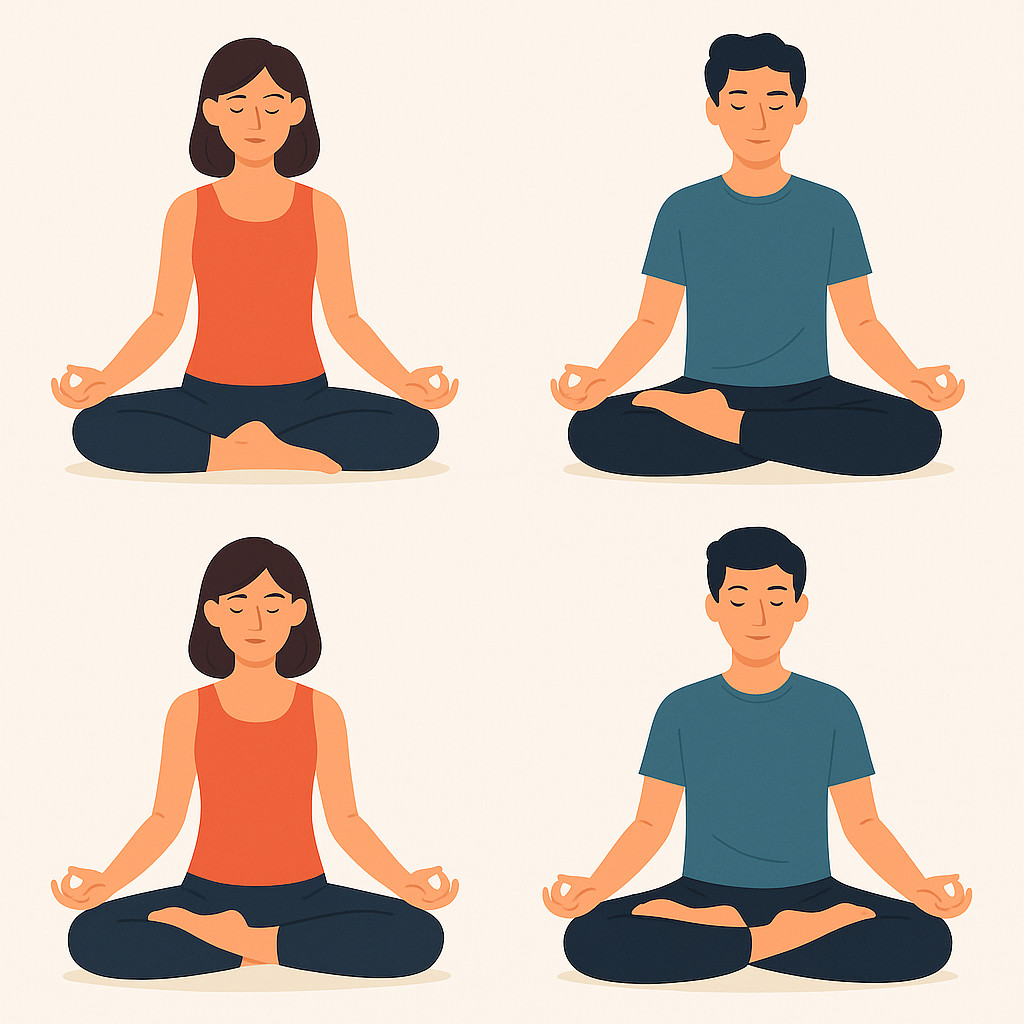Lotus Position
🌸 The Lotus Position: Stillness with Roots
The lotus position — or Padmasana — is one of the most recognizable postures in meditation and yoga. Cross-legged, steady, calm — it has come to symbolize inner peace. Yet for most people, the real story of lotus isn’t about flexibility or performance. It’s about learning to sit with ease, one gentle layer at a time.

The image show half lotus on the top and full lotus on the bottom. Notice the feets position.
Why the Lotus Became Iconic
In traditional yoga, the lotus symbolizes purity — rising from muddy water yet unstained. The seated posture reflects the same idea: stability and openness in the midst of life’s movement. Over time, it became a favorite for meditation because:
- The upright spine supports deep, relaxed breathing.
- The symmetry of both legs folded helps you stay balanced and still.
- The grounded base allows the upper body to soften while remaining alert.
You’ll see it in statues, temples, and modern meditation apps alike — not because it’s a test of flexibility, but because it expresses quiet presence.
How Much Effort Does It Take?
For an average adult who hasn’t done much stretching, the lotus position can take weeks to months of gentle preparation.
- Half lotus (one foot on the opposite thigh) is usually reachable within a few weeks if you practice hip-opening stretches regularly.
- Full lotus (both feet on opposite thighs) can take several months or longer — and may not be comfortable for everyone.
The key isn’t to force it. Healthy hips and knees come from gradual opening, not pushing. Sitting on a cushion or folded blanket to lift the hips above the knees helps a lot.
If your knees or ankles ever feel sharp pain, stop immediately. Many lifelong meditators never use full lotus, and that’s perfectly fine. The goal is a stable, relaxed seat, not an acrobatic one.
How to Get Into Half Lotus (Ardha Padmasana)
- Start easy: Sit cross-legged on a firm cushion or folded blanket. The hips should be slightly higher than the knees.
- Position the first leg: Bend your right knee and place your right foot on your left thigh, close to the hip crease, sole facing upward.
- Adjust the base: Keep your left leg bent with the foot resting under the right thigh (or relaxed in front).
- Find balance: Press your sitting bones gently into the cushion and lengthen your spine upward.
- Rest your hands: Place your palms on your knees, palms up, fingers relaxed.
- Breathe: Inhale softly through the nose, let your belly expand, and exhale fully.
If the knees are high off the floor or hips feel tight, that’s okay — stay here, breathe, and give the joints time to adapt. Switch sides regularly so both hips open evenly.
How to Progress Toward Full Lotus (Padmasana)
- Begin in Half Lotus: Start with your right foot on the left thigh.
- Lift the second leg: Gently bend your left knee and bring the left foot onto the right thigh.
- Settle carefully: Adjust both knees toward the floor. Ideally, both feet rest on opposite thighs with soles up.
- Lengthen and relax: Keep the spine tall and shoulders soft. Don’t let the lower back round.
- Stay only as long as comfortable: Even experienced practitioners often alternate legs or return to half lotus during longer meditations.
Never force the legs or push the knees down — the motion should come from the hips, not the joints below them.
A Simpler Truth
Lotus is beautiful, but it’s not a requirement for calm. A chair, cushion, or kneeling bench can serve the same purpose — helping your spine stay tall while your mind grows still.
With patient practice, even half lotus becomes less about stretching and more about feeling grounded — your body like the roots, your breath like the blossom.
This blog-post was authored by AI.